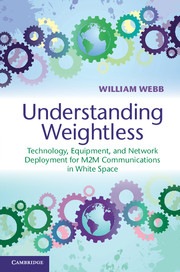 Understanding Weightless
Understanding Weightless Published online by Cambridge University Press: 05 April 2012
Defining white space
Most of the spectrum below 10GHz across most of the world is allocated for particular applications and assigned to certain users. These include broadcasters, mobile phone network operators, defence departments and many, many more. The net result is that there is little obviously spare spectrum, particularly in the preferred frequency bands between around 300MHz and 3GHz where propagation is favourable but antennas are conveniently small. However, measurements of the actual utilisation of this assigned spectrum suggest that it is typically only used in around 20% of the locations. Such measurements undoubtedly underestimate usage but nevertheless it is clear that there is some potential for more efficient use of the spectrum.
One way to visualise where there might be underused spectrum is to plot on a map the strength of signal from the licensed user of that band. If colours are used to represent signal strength then those parts with no coverage at a given frequency will be uncoloured and appear white on a black and white map. Hence the term ‘white space’ for areas where there is potential for others to use the spectrum.
To save this book to your Kindle, first ensure [email protected] is added to your Approved Personal Document E-mail List under your Personal Document Settings on the Manage Your Content and Devices page of your Amazon account. Then enter the ‘name’ part of your Kindle email address below. Find out more about saving to your Kindle.
Note you can select to save to either the @free.kindle.com or @kindle.com variations. ‘@free.kindle.com’ emails are free but can only be saved to your device when it is connected to wi-fi. ‘@kindle.com’ emails can be delivered even when you are not connected to wi-fi, but note that service fees apply.
Find out more about the Kindle Personal Document Service.
To save content items to your account, please confirm that you agree to abide by our usage policies. If this is the first time you use this feature, you will be asked to authorise Cambridge Core to connect with your account. Find out more about saving content to Dropbox.
To save content items to your account, please confirm that you agree to abide by our usage policies. If this is the first time you use this feature, you will be asked to authorise Cambridge Core to connect with your account. Find out more about saving content to Google Drive.